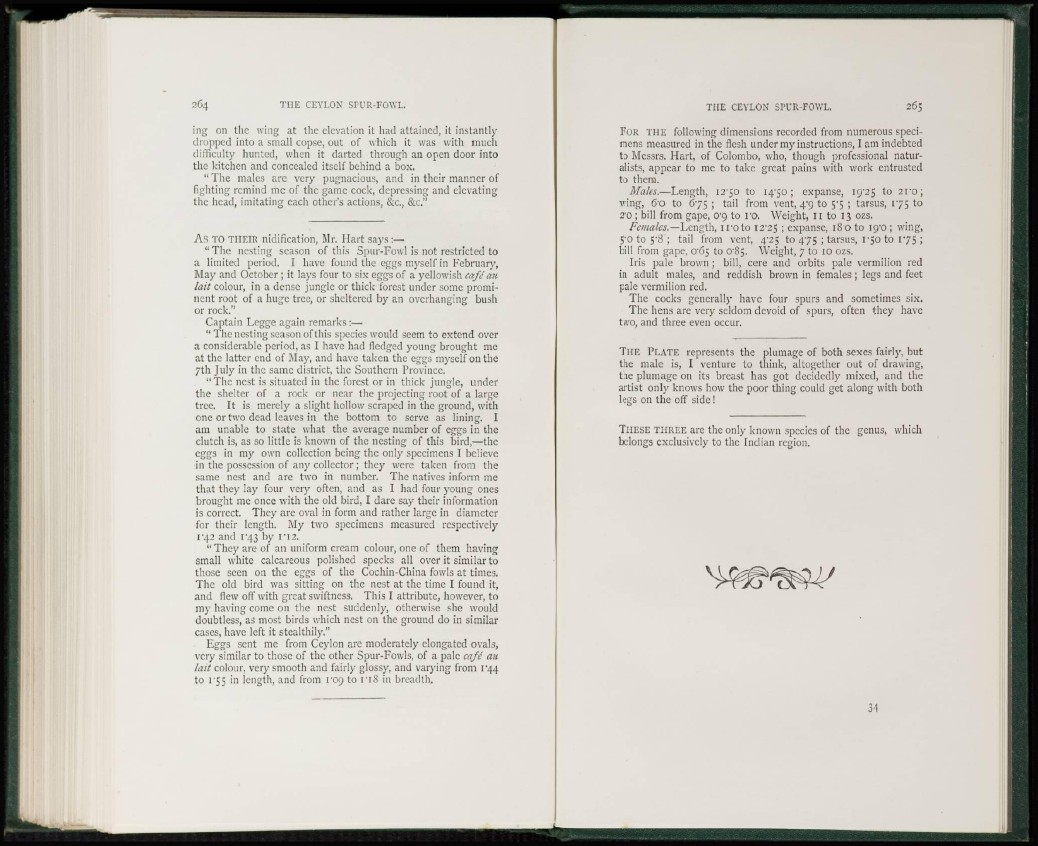
ing on the wing at the elevation it had attained, it instantly
dropped into a small copse, out of which it was with much
difficulty hunted, when it darted through an open door into
the kitchen and concealed itself behind a box.
"The males arc very pugnacious, and in their manner of
fighting remind me of the game cock, depressing and elevating
the head, imitating each other's actions, &c, &c."
As TO THEIR nidification, Mr. Hart says :—
" T h e nesting season of this Spur-Fowl is not restricted to
a limited period. I have found the eggs myself in February,
May and October ; it lays four to six eggs of a yellowish café an
lait colour, in a dense jungle or thick forest under some prominent
root of a huge tree, or sheltered by an overhanging bush
or rock."
Captain Legge again remarks :—•
" The nesting season of this species would seem to extend over
a considerable period, as I have had fledged young brought me
at the latter end of May, and have taken the eggs myself on the
7 th July in the same district, the Southern Province.
" The nest is situated in the forest or in thick jungle, under
the shelter of a rock or near the projecting root of a large
tree. It is merely a slight hollow scraped in the ground, with
one or two dead leaves in the bottom to serve as lining. I
am unable to state what the average number of eggs in the
clutch is, as so little is known of the nesting of this bird,—the
eggs in my own collection being the only specimens I believe
in the possession of any collector ; they were taken from the
same nest and are two in number. The natives inform me
that they lay four very often, and as I had four young ones
brought me once with the old bird, I dare say their information
is correct. They are oval in form and rather large in diameter
for their length. My two specimens measured respectively
1-42 and 1 '43 by I'I2.
"They are of an uniform cream colour, one of them having
small white calcareous polished specks all over it similar to
those seen on the eggs of the Cochin-China fowls at times.
The old bird was sitting on the nest at the time I found it,
and flew off with great swiftness. This I attribute, however, to
my having come on the nest suddenly, otherwise she would
doubtless, as most birds which nest on the ground do in similar
cases, have left it stealthily."
Eggs sent me from Ceylon are moderately elongated ovals,
very similar to those of the other Spur-Fowls, of a pale café au
lait colour, very smooth and fairly glossy, and varying from 1*44
to 155 in length, and from fog to i'i8 in breadth.
FOR THE following dimensions recorded from numerous specimens
measured in the flesh under my instructions, I am indebted
to Messrs. Hart, of Colombo, who, though professional naturalists,
appear to me to take great pains with work entrusted
to them.
Males.—Length, 1250 to i4'5o ; expanse, ig'25 to 2i'0;
wing, 6'o to 675 ; tail from vent, 4'g to 5'5 ; tarsus, 175 to
2-o ; bill from gape, 09 to ro. Weight, 11 to 13 ozs.
Females.—Length, i r o t o I2'25 ; expanse, 180 to ig'O ; wing,
5'0 to 5-8 ; tail from vent, 4^25 to 475 ; tarsus, 1-50 to 175 ;
bill from gape, 0'6s to C85. Weight, 7 to 10 ozs.
Iris pale brown ; bill, cere and orbits pale vermilion red
in adult males, and reddish brown in females ; legs and feet
pale vermilion red.
The cocks generally have four spurs and sometimes six.
The hens are very seldom devoid of spurs, often they have
two, and three even occur.
T H E PLATE represents the plumage of both sexes fairly, but
the male is, I venture to think, altogether out of drawing,
the plumage on its breast has got decidedly mixed, and the
artist only knows how the poor thing could get along with both
legs on the off side!
THESE THREE are the only known species of the genus, which
belongs exclusively to the Indian region.